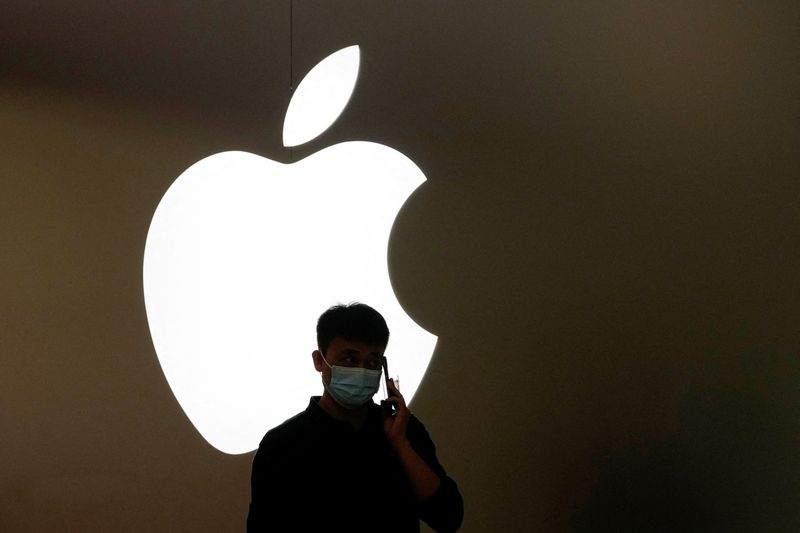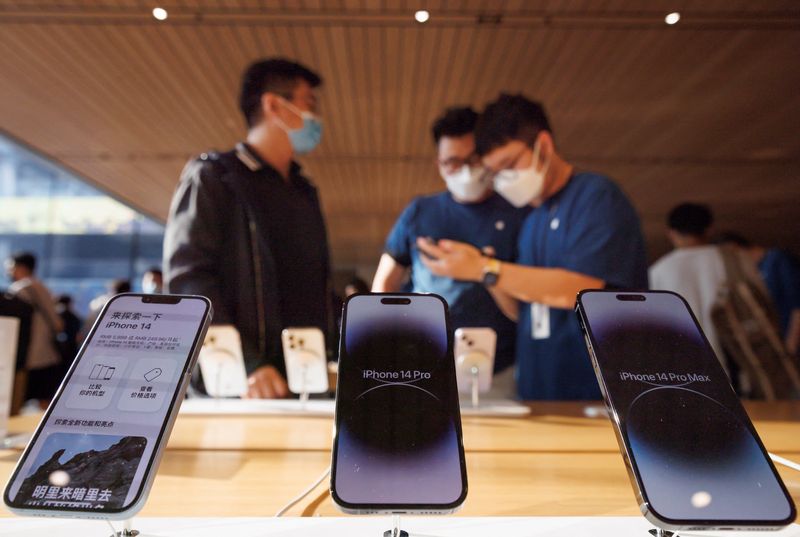By Josh Horwitz
SHANGHAI (Reuters) - Apple Inc's wide exposure to Chinese manufacturing, notable both for its low costs and rising risks, has receded since the COVID-19 pandemic began, company supply chain data shows.
With the world's biggest iPhone factory, operated in central China by Foxconn, battling production shortfalls and labour unrest spurred largely by Beijing's harsh virus containment policies, analysts expect the risks - and Apple's retreat - to accelerate.
A Reuters analysis of Apple's supply chain data shows China's prominence in the company's global manufacturing is declining: In the five years to 2019, China was the primary location of 44% to 47% of its suppliers' production sites, but that fell to 41% in 2020, and 36% in 2021.
Apple did not reply to a request for comment.
The data shows how a diversification drive by Apple and its suppliers, with investments in India and Vietnam and increased procurement from Taiwan, the United States and elsewhere, is reshaping the global supply structure, although analysts and academics say it will remain heavily exposed to China for many years to come.
"The China supply chain is not going to evaporate overnight," said Eli Friedman, an associate professor at Cornell University who studies labour in China.
"Decoupling is just not realistic for these companies for the time being," he said, although he expected diversification to accelerate.
The concentration of suppliers in China, the site of most production by Foxconn which accounts for 70% of iPhones made globally, has been a key feature for Apple, the world's most profitable smartphone vendor.
But the strategy is shifting, driven not just by China's COVID-related lockdowns and restrictions, but by rising trade and geopolitical tensions between Beijing and Washington that pose potential long-term risks.
Foxconn is stepping up its expansion in India, with a plan to quadruple the workforce at its iPhone factory over two years, government officials with knowledge of the matter told Reuters earlier this month.
J.P.Morgan expects Apple to move about 5% of iPhone 14 production to India from late this year and to make one in four iPhones in India by 2025, and estimates that about 25% of all Apple products, including Mac PCs, iPads, Apple Watches and AirPods, will be manufactured outside China by 2025 versus 5% now.
The Apple supplier data to 2021, however, shows no locations so far that stand out as substantial gainers to match China's decline, according to the Reuters analysis.
The United States rose the most to 10.7% in 2021 from 7.2% in 2019, followed by Taiwan with an increase to 9.5% from 6.7%. India was still a relatively minor presence, rising to 1.5% from less than 1%, while Vietnam expanded to 3.7% from 2.2%.
"Vietnam and India are not China. They can't produce at that scale, at the quality and with the turnaround time, with the reliability of infrastructure," said Cornell University's Friedman.
Apple's annual data covers more than 600 locations among its top suppliers, which represent 98% of Apple's direct spending. Apple does not disclose how much it spends with each supplier, and those on the list can change each year as different companies make the cutoff among Apple's thousands of suppliers.
They include contract manufacturers that assemble iPhones, iPads, watches and wireless headphones, as well as suppliers of chips, glass, aluminium casings, cables, circuit boards and other components.
While Apple's shift from China is increasingly evident, including in its own supply chain data, so too are the risks from the concentration of operations there.
The labour issues at Foxconn's China plant are due in large part to the demands of Beijing's COVID containment policy, which require that workers be isolated from the wider world in closed-loop systems to keep factory lines operating.

The unrest has attracted the attention of investors, who are conscious of the human rights aspects as well as production targets.
"The important thing is that the company implements these orders in a way which respects people's rights," said Pia Gisgard, head of sustainability and governance at Swedbank Robur, which held Apple shares (NASDAQ:AAPL) worth around $1.3 billion as of end-September according to Refinitiv data.
